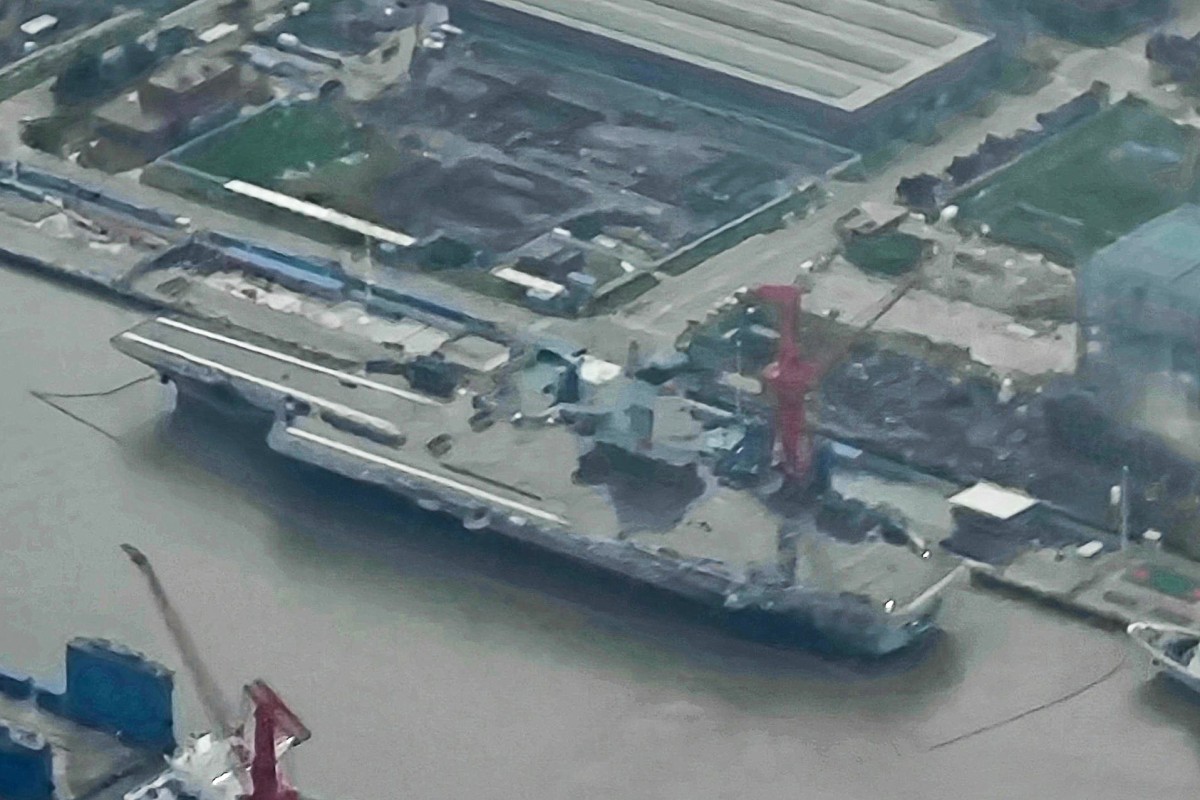beijingwalker
ELITE MEMBER

- Joined
- Nov 4, 2011
- Messages
- 65,194
- Reaction score
- -55
- Country
- Location
China’s most advanced Fujian aircraft carrier on track for 2025 PLA handover, latest Weibo photos suggest
- Covers taken off all three electromagnetic catapults on the deck of the Fujian, social media photos posted by military buffs show
- Images indicate readiness for sea trials and systems testing, with warship likely to join the PLA within two years as scheduled, observers say
Published: 6:00am, 7 Sep, 2023

All covers appear to have been removed from the three advanced electromagnetic catapults on the Fujian flight deck. Photo: Weibo
China’s third and most advanced aircraft carrier is close to undergoing its first sea trials, latest photos posted online by military buffs suggest, taking the giant warship a step closer to becoming an actual combat platform.
The pace of progress indicates that the Fujian, a 1,037-foot (316m) supercarrier, is ready to test its aircraft launch systems and will join the Chinese navy in 2025 as scheduled, military experts said.
Images posted by military enthusiasts on Chinese microblogging site Weibo earlier this week showed the covers had been removed from all three advanced electromagnetic catapults on the deck of the Fujian – offering outsiders a glimpse of its entire aircraft launch system for the first time.
One of the covers was also seen to have been removed about two months ago, suggesting imminent take-off tests.
“Removing all the protective covers means debugging work of the electromagnetic catapults has been completed, allowing the aircraft launch systems to work during sea trial,” Song Zhongping, a former instructor for the People’s Liberation Army, said.
Pictures circulating on Chinese social media platforms over the weekend also showed smoke coming out of the warship’s chimney, indicating intensive tests of the main propulsion system and other equipment were under way.
Song said the first sea trials would take place only in nearshore waters, and the process might go on for at least a year.
It is likely to involve six months of sea trials, followed by a further year-long testing of specific equipment and weapon systems, he said.
“The sea trials will mainly focus on testing the carrier’s propulsion, navigation and communication systems, and then it can enter the second stage to go through [the testing of] other ship-borne equipment,” Song said.
Lu Li-shih, a former instructor at the Taiwanese naval academy in Kaohsiung, said he expected the Fujian to test the J-15T – a carrier-based, catapult-type fighter jet.
“The removal of the covers means the electromagnetic catapults are ready to launch the J-15T, because the launch system is not a new thing for the PLA,” Lu said.
He said satellite pictures from the navy’s training base near Xingcheng, in northeastern Liaoning province, showed PLA troops had been undergoing simulation training for J-15T take-off and landing operations off a land-based catapult system since 2016.
The J-15T is an upgraded, catapult-type version of the J-15 “Flying Shark”, a fourth generation aircraft and China’s only ship-borne fighter jet.
The original J-15 is now operating off China’s two active aircraft carriers, the Liaoning and Shandong. Both the Liaoning, a refitted ex-Soviet vessel that became China’s first aircraft carrier, and the Chinese-built Shandong feature the Russian-designed less-advanced ski-jump ramp for take-offs.
China is also developing a new generation carrier-based stealth fighter that could compete with the US Navy’s F-35C jet.
The Fujian originally featured three conventional steam-powered catapults, as China does not have a ship-borne nuclear reactor – as all US aircraft carriers do.
But the design was changed in 2017 following a decision by President Xi Jinping, who also chairs the all-powerful Central Military Commission, the Post reported earlier. Instead of steam catapults, the Fujian was then fitted with a new integrated propulsion system capable of powering advanced electromagnetic launch systems.
With a displacement of more than 80,000 tonnes – some 20,000 tonnes more than either the Liaoning or Shandong – the conventionally powered Fujian is the first of the PLA Navy’s Type 003 class warships.
It is also only the world’s second aircraft carrier to use an electromagnetic catapult system for flight deck launches, after the US Navy’s nuclear-powered Gerald R. Ford class.
Launched in June last year, the Fujian has been undergoing mooring and propulsion tests since March at the Shanghai shipyard where it was built. Social media pictures in July showing one of its three catapults uncovered also revealed an array of radar systems installed in the control tower island of the Fujian.
Zhou Chenming, a researcher with the Beijing-based Yuan Wang military science and technology think tank, also said the Fujian would need to undergo another round of specific operational equipment assessments following the first sea trials.
This would include checks on damage control, fuel pipe, circuitry, communications, radar and sonar, and other systems, he said.
“If nothing is wrong, the ship will be handed over to the PLA Navy in 2025 as scheduled.”

China’s giant Fujian aircraft carrier on track for ‘2025 PLA handover’
Covers have been taken off all three electromagnetic catapults on the deck of the Fujian, social media photos show, indicating readiness for sea trials and systems testing, and PLA handover as scheduled.
